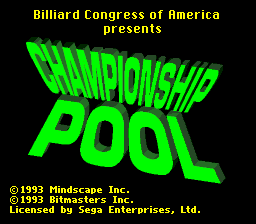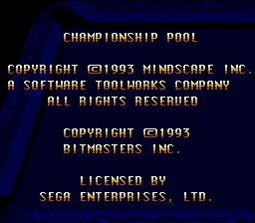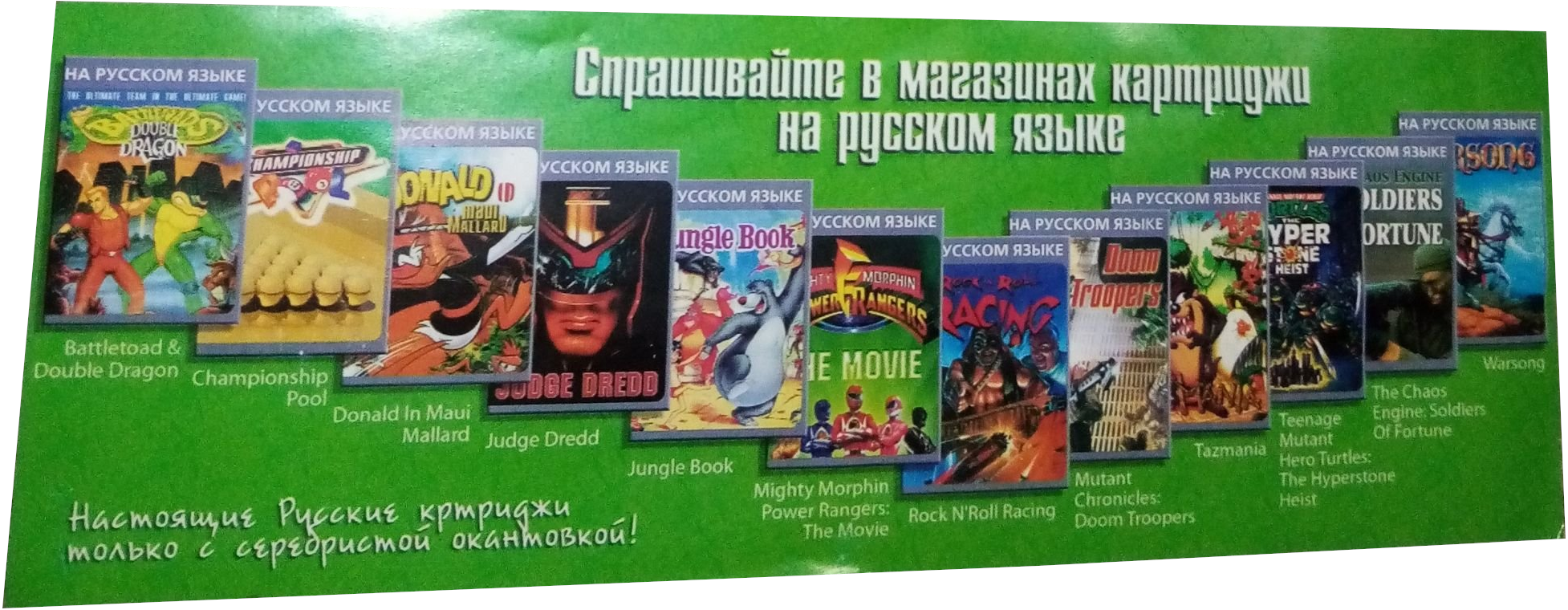Championship Pool
From Sega Retro
| Championship Pool | |||||||||||||||||||||||||
|---|---|---|---|---|---|---|---|---|---|---|---|---|---|---|---|---|---|---|---|---|---|---|---|---|---|
| System(s): Sega Mega Drive | |||||||||||||||||||||||||
| Publisher: Mindscape | |||||||||||||||||||||||||
| Developer: Bitmasters | |||||||||||||||||||||||||
| Licensor: The Billiard Congress of America | |||||||||||||||||||||||||
| Sound driver: GEMS | |||||||||||||||||||||||||
| Genre: Sports, Table (billiards) | |||||||||||||||||||||||||
| Number of players: 1-8 (alternating) | |||||||||||||||||||||||||
| |||||||||||||||||||||||||
|
The Billiard Congress of America presents Championship Pool is a Sega Mega Drive pool game developed by Bitmasters and published by Mindscape. It was only released in North America.
A Japanese version, set to be published as Super Billiard (スーパービリヤード) by Imagineer was planned but cancelled.
Contents
Gameplay
The game is a virtual pool simulator that recreates several billiards games. The player may play against the computer or up to seven other players (taking turns using the same control pad).
To make a shot, the player can move the cursor anywhere on the table using the D-Pad. Holding ![]() before moving the D-Pad moves the cursor more slowly; holding
before moving the D-Pad moves the cursor more slowly; holding ![]() after moving the D-Pad moves the cursor more quickly. Pressing
after moving the D-Pad moves the cursor more quickly. Pressing ![]() activates the "phantom ball," an outline of the ball that repeatedly moves quickly from the cue ball to show the trajectory that it takes when hit. Pressing
activates the "phantom ball," an outline of the ball that repeatedly moves quickly from the cue ball to show the trajectory that it takes when hit. Pressing ![]() again hits the cue ball towards the direction of the cursor.
again hits the cue ball towards the direction of the cursor.
Before hitting the cue ball, the power of the hit can be adjusted by pressing ![]() and using
and using ![]() and
and ![]() . The phantom ball moves faster when the power of the shot is higher. To adjust the spin, the player can press START to open the pause menu, then select "Set Spin" and use the D-Pad to change the strike point of the cue stick or
. The phantom ball moves faster when the power of the shot is higher. To adjust the spin, the player can press START to open the pause menu, then select "Set Spin" and use the D-Pad to change the strike point of the cue stick or ![]() or
or ![]() to lower or raise the angle of the stick. Hitting the ball on the sides puts spin on the ball and causes it to take a curved (rather than straight) path. Hitting on the top causes the cue ball to bounce back after hitting, while hitting on the bottom causes it to follow. Raising the stick angle does a massé shot, causing the cue ball to curve, and lowering the angle can jump the cue ball. The game remembers the power after each shot, but the aim resets.
to lower or raise the angle of the stick. Hitting the ball on the sides puts spin on the ball and causes it to take a curved (rather than straight) path. Hitting on the top causes the cue ball to bounce back after hitting, while hitting on the bottom causes it to follow. Raising the stick angle does a massé shot, causing the cue ball to curve, and lowering the angle can jump the cue ball. The game remembers the power after each shot, but the aim resets.
The game uses an overhead perspective of the entire table by default, but pressing HOLD START ![]() cycles between a close-up overhead view, a close-up angled view, then back to the overhead view. While in the close-up angled view, pressing HOLD START
cycles between a close-up overhead view, a close-up angled view, then back to the overhead view. While in the close-up angled view, pressing HOLD START ![]() or
or ![]() rotates the perspective around the table.
rotates the perspective around the table.
In the pause menu in every mode, there are options to watch a replay of the last shot or toggle the display of ball numbers.
Modes
There are four modes:
- Freestyle: A single-player practice mode, where no rules are enforced. The game lets the player choose the initial rack (which also determines the number of balls), which can be chosen randomly. The player can rearrange the table by hovering over a ball, pressing
 to pick it up, and pressing
to pick it up, and pressing  to drop it anywhere. The pause menu contains options to undo the last shot, spot balls (the last sunk or the lowest number), or re-rack the balls.
to drop it anywhere. The pause menu contains options to undo the last shot, spot balls (the last sunk or the lowest number), or re-rack the balls. - Party: The multiplayer mode, where two to eight players can compete against each other. Players can choose how many racks are needed to win a match (from 1 to 7). In two-player games, the players flip a coin to determine who breaks (player one chooses head or tails); in games with more than two players, the players go in order (with player one breaking).
- Tournament: A single-player mode consisting of two single-elimination tournaments against computer players. The first tournament is a qualifying tournament, followed by the BCA World Championship if the player wins. Both tournaments consist of 5 matches that are a "race to 4" (whichever player wins four racks wins). A coin toss determines which player breaks first, and the player has the option to enable automatic breaks. Automatic breaks and the computer's turns are not shown; the game skips ("time warps") straight to the player's inning.
- Challenge: A single-player mode where the player plays a game without a competitor. Some of the games have slightly different rules in Challenge mode.
In the Freestyle and Party modes, each player can choose their aiming difficulty (Too Easy, Normal, Hard, and Too Tough), which affects the accuracy of shots. Too Easy, Normal, and Hard show the trajectory of one bank (where the cue ball travels after hitting a rail or where the object ball travels after being hit by the cue ball), but Too Tough only shows the trajectory of the initial shot. The easier difficulties are more accurate, while the harder difficulties are more likely to miss shots.
Several different pool games are available depending on the chosen mode:
| Ruleset | Players | Freestyle | Party | Tournament | Challenge |
|---|---|---|---|---|---|
| Three Ball | 1-8 | Yes | Yes | No | Yes |
| Eight Ball | 1-2 | Yes | Yes | Yes | Yes |
| Nine Ball | 1-8 | Yes | Yes | Yes | Yes |
| Ten Ball | 1-8 | Yes | Yes | No | No |
| 14.1 Continuous | 1-2 | No | Yes | No | Yes |
| Rotation | 1-8 | Yes | Yes | No | No |
| Fifteen Ball | 2-8 | No | Yes | No | No |
| Basic | 2 | No | Yes | No | No |
| Equal Offense | 1-8 | No | Yes | No | Yes |
| Cutthroat | 1 | Yes | No | No | No |
| One Pocket | 2 | No | Yes | No | No |
| Speed Pool | 1-8 | No | Yes | No | Yes |
Rules
Three Ball
Played by up to eight players with 3 object balls. The goal is to pocket the balls in the fewest moves possible. The player's inning continues until all three balls are sunk (even after missed shots), then the next player starts with a new rack. If a player scratches, the player's score increases, all balls pocketed on the scratch shot are spotted, and the player shoots again.
Eight Ball
Played by up to two players with 15 object balls. One player pockets the solid-colored balls (1-7), and the other player pockets the striped balls (9-15). When a player has pocketed all of their object balls, the 8-ball (black) must be pocketed to win. Players should call the ball and pocket on every shot (but this is not enforced by the game).
The player must pocket a ball on the break or drive at least four balls to a rail, or the next player can choose to break again. After pocketing a ball on the break, the shooting player can choose solids or stripes. If the 8-ball is pocketed on the break, it is spotted.
The player's inning continues until the player fails to sink a ball legally or scratches. On a scratch, any balls pocketed on the scratch shot stay pocketed, but the other player gets ball in hand. The first player to pocket all of their object balls and then the 8-ball wins. A player loses by pocketing the 8-ball on a foul (without pocketing all of their object balls first) or pocketing the 8-ball without calling it first.
In Challenge mode, the player gets 10 points for each sunk ball, then 50 points for the 8-ball. The player plays three rounds, with a round ending if the player misses or fouls.
Nine Ball
Played by up to eight players with 9 object balls. On each shot, the cue ball must hit the lowest-numbered ball on the table first. Usually, this means pocketing the balls in order, but it is legal to pocket a ball out of order as long as the lowest-numbered ball is hit by the cue ball first. After pocketing every other object ball, the player who sinks the 9-ball wins.
On a break, the player must hit the 1-ball first or drive at least four balls to a rail, or it is a foul and the other player gets ball in hand. It is possible to win in one shot by pocketing the 9-ball on the break. The player's inning continues until the player fails to sink a ball legally or fouls (by scratching or by failing to hit the lowest-numbered ball first). A player loses by fouling three times in three successive shots.
In Challenge mode, the player gets 10 points for each sunk ball, then 50 points for the 9-ball. The player plays three rounds, with a round ending if the player misses or fouls.
Ten Ball
Played by up to eight players with 10 object balls. This game is a variant of Nine Ball but with ten balls. On each shot, the cue ball must hit the lowest-numbered ball on the table first. Usually, this means pocketing the balls in order, but it is legal to pocket a ball out of order as long as the lowest-numbered ball is hit by the cue ball first. After pocketing every other object ball, the player who sinks the 10-ball wins.
On a break, the player must hit the 1-ball first or drive at least four balls to a rail, or it is a foul and the other player gets ball in hand. Unlike Nine Ball, if the "money ball" (the 10-ball) is pocketed on the first shot, it is spotted. The player's inning continues until the player fails to sink a ball legally or fouls (by scratching or by failing to hit the lowest-numbered ball first). A player loses by fouling three times in three successive shots.
14.1 Continuous
Played by up to two players with 15 object balls. This game is also called "straight pool." It is played up to a certain number of points (15, 25, 50, 100, or 150). Players can pocket balls in any order and earn points for every ball pocketed. Balls are all worth one point. Players should call the ball and pocket on every shot (but this is not enforced by the game). Object balls are re-racked when 14 have been pocketed and one remains on the table, and the game continues until a player reaches the chosen point threshold and wins.
The player's inning continues until the player fails to sink a ball legally or scratches. Touching a ball while it is moving is a 16-point penalty. Illegally pocketed balls are spotted with no penalty. Fouling three times in three successive shots incurs a 15-point penalty.
In Challenge mode, the game continues until the player misses or fouls.
Rotation
Played by up to eight players with 15 object balls. The goal is to get a higher score than the other players. Each ball is given a point value equal to its number. The lowest-numbered ball must be hit by the cue ball first on each shot. The game is played until all balls have been pocketed, then the player with the highest score wins.
The player's inning continues until the player fails to sink a ball legally or scratches. A player loses by fouling three times in three successive shots.
Fifteen Ball
Played by two to eight players with 15 object balls. The goal is to get a higher score than the other players. Each ball is given a point value equal to its number. Balls can be hit in any order and are all worth the same amount. The game is played until all balls have been pocketed, then the player with the highest score wins. The player's inning continues until the player fails to sink a ball legally or scratches.
Basic
Played by two players with 15 object balls. The goal is to sink eight balls before the other player. Players should call the object ball but do not need to call the pocket on every shot (but this is not enforced by the game). The player's inning continues until the player fails to sink a ball legally or scratches.
Equal Offense
Played by up to eight players with 15 object balls. The game is played to a certain number of rounds (1, 3, 5, 7, or 10), with a maximum of 20 points per inning. Every player gets one inning for each round. Balls can be sunk in any order. Players should call the ball and pocket on every shot (but this is not enforced by the game). Players shoot in descending order of the highest scorer after the first inning. The player with the highest score at the end of the chosen number of rounds is the winner. Ties are broken by a "sudden death" round where the first player to sink a ball wins.
In Challenge mode, the game is always played for five rounds.
Cutthroat
This game is only available in the Freestyle mode, where there are no rules enforced. It has a rack of 15 object balls.
One Pocket
Played by two players with 15 object balls. Player one can only sink balls into the lower-left pocket, and player two can only sink balls into the upper-right pocket. Points are earned for each ball pocketed, with the winner being the player with the most points after all balls are pocketed. There is no penalty for sinking a ball into any other pocket, but it does not contribute to the player's score. The player's inning continues until the player fails to sink a ball legally or scratches.
Speed Pool
Played by up to eight players with 15 object balls. The player who pockets every ball in the fastest time wins. The player's inning continues until all 15 balls are sunk (even after missed shots), then the next player starts with a new rack. If a player scratches, the cue ball is spotted and the player shoots again.
In Challenge mode, the player plays against the clock and tries to sink all 15 balls as quickly as possible. The player plays three rounds, with the score being the total time after all three rounds.
Production credits
- Game Design: Franz Lanzinger, David O'Riva
- Graphics and Animation: Greg Hancock, Merlin
- Programming: Franz Lanzinger, David O'Riva
- Music Composition: Jerry Gerber, Dave O'Riva
- Sound Effects: Dave O'Riva, LX Rudis
- Producer: Jim Molitor
- Testing: Marty LaFleur, Scot Lane, Randy Lee, Hugh Mason, Frank Coles, Dave Polcyn, Jon Howe, Kevin, Phil Handy, Rob Vance
- Special Thanks: John Lewis, Glen Hendrickson, Bruce Maurer
Magazine articles
- Main article: Championship Pool/Magazine articles.
Promotional material
Physical scans
| Sega Retro Average | |||||||||||||||||||
|---|---|---|---|---|---|---|---|---|---|---|---|---|---|---|---|---|---|---|---|
|
| 53 | |
|---|---|
| Based on 3 reviews | |
Technical information
- Main article: Championship Pool/Technical information.
References
- ↑ File:Championship Pool MD credits.pdf
- ↑ 1700 igr dlya Sega, "" (RU; 2001-xx-xx), page 71
- ↑ Mean Machines Sega, "July 1994" (UK; 1994-05-28), page 80
- ↑ Tricks 16 bit, "Tricks Sega Gold 800 igr" (RU; 1998-03-20), page 41
| Championship Pool | |
|---|---|
|
Main page | Comparisons | Magazine articles | Reception | Region coding | Technical information | Bootlegs | |
- 1-8 player games
- US Mega Drive games
- All US games
- US Sega Channel games
- EU Mega Drive games
- All EU games
- EU Sega Channel games
- SA Mega Drive games
- All SA games
- SA Sega Channel games
- Mega Drive games
- 1994 Mega Drive games
- All 1994 games
- Mega Drive billiards games
- Mega Drive table games
- All table games
- All games
- Championship Pool









